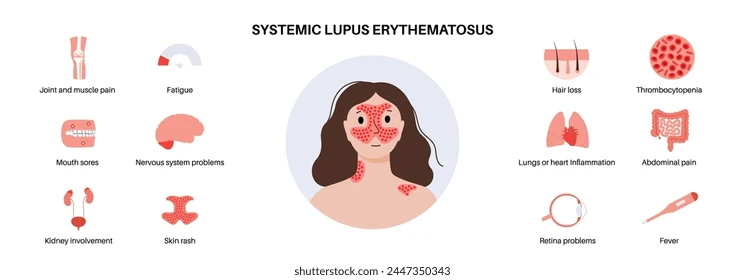
Lupus is a complex autoimmune disease that affects millions of people worldwide, with women being disproportionately affected. In fact, lupus is nine times more common in women than in men, particularly among those of childbearing age. Understanding lupus symptoms in women is essential for early detection and proper management. Since lupus can present itself in various ways, recognizing the symptoms early can help prevent long-term damage to organs and tissues. This blog will explore the unique symptoms of lupus in women, gender differences, and what to watch out for when it comes to this autoimmune disorder.
What is Lupus?
Lupus is an autoimmune disorder in which the immune system mistakenly attacks healthy tissues and organs. It can affect almost any part of the body, including the skin, joints, kidneys, heart, and lungs. The most common form of lupus is systemic lupus erythematosus (SLE), which can affect multiple organs. Another form, discoid lupus, primarily affects the skin.
Lupus is a chronic disease, meaning that it persists over time and tends to come in cycles of flare-ups and remissions. During a flare-up, symptoms worsen, and during periods of remission, symptoms may improve or disappear altogether.
While lupus can affect anyone, it is more prevalent in women, particularly those in their reproductive years, between the ages of 15 and 44. This blog will focus on lupus symptoms in women, highlighting how the disease presents differently in women compared to men and why women need to be especially vigilant.
Lupus Symptoms in Women: Key Indicators
1. Fatigue and Low Energy
Fatigue is one of the most common and debilitating symptoms of lupus. Women with lupus often describe feeling exhausted even after a full night’s sleep. This overwhelming tiredness can interfere with daily activities and be mistaken for general tiredness or stress. Unlike regular fatigue, lupus fatigue tends to be more persistent and doesn’t improve with rest.
In addition to physical exhaustion, lupus fatigue can affect mental clarity and concentration, often referred to as “brain fog.” Brain fog can make it difficult to focus, remember things, and carry out everyday tasks.
2. Butterfly Rash (Malar Rash)
The butterfly-shaped rash, also known as a malar rash, is one of the most distinctive and noticeable symptoms of lupus. It typically appears across the cheeks and the bridge of the nose, forming a shape that resembles a butterfly. The rash is red or purple and is often more pronounced after sun exposure.
While the butterfly rash is not always present, its appearance is a classic sign of lupus and can be a clue for diagnosis. It’s important to note that exposure to ultraviolet (UV) light can trigger or worsen the rash, and women with lupus should be particularly cautious about sun exposure.
3. Joint Pain and Swelling
Joint pain and swelling are also prevalent lupus symptoms in women. Lupus often affects the small joints in the hands, wrists, and feet, but it can also affect larger joints such as the elbows and knees. The pain and swelling may be intermittent, often worsening during a flare-up.
Lupus-related joint pain can sometimes mimic other forms of arthritis, such as rheumatoid arthritis, but with lupus, the pain usually doesn’t lead to permanent joint damage. However, it can still be debilitating and affect mobility. Joint stiffness, especially in the morning, is also a common complaint.
4. Photosensitivity (Sun Sensitivity)
Women with lupus often experience photosensitivity, which is an increased sensitivity to sunlight. Sun exposure can trigger lupus flare-ups and cause rashes, fatigue, and other symptoms. Photosensitivity can also exacerbate the butterfly rash and lead to increased discomfort.
To manage photosensitivity, it’s important for women with lupus to wear protective clothing, use sunscreen with a high SPF, and avoid prolonged exposure to the sun. Some individuals may also find relief in using specialized sunglasses to protect their eyes from UV rays.
5. Hair Loss
Hair loss, or alopecia, is a common lupus symptom, especially in women. It can occur gradually, or in some cases, suddenly. The hair loss is typically non-scarring, meaning the hair follicles remain intact, and hair can regrow after treatment. However, hair loss can still be emotionally distressing.
The exact cause of hair loss in lupus is unclear, but it’s thought to be related to inflammation in the scalp and the overall stress that lupus places on the body. Stress, medication side effects, and the disease’s impact on hormones can also contribute to hair thinning or shedding.
6. Kidney Problems (Lupus Nephritis)
Lupus nephritis is a serious complication of lupus that affects the kidneys. It occurs when the immune system attacks the kidneys, leading to inflammation. Early signs of kidney problems include swelling in the feet and ankles, high blood pressure, and changes in urine (such as foamy or dark urine). However, kidney involvement can often go unnoticed until it becomes severe.
Since lupus nephritis can lead to kidney failure if untreated, it is essential for women with lupus to undergo regular kidney function tests, especially if they experience any of the early warning signs of kidney problems.
7. Chest Pain and Shortness of Breath
Lupus can cause inflammation in the lining of the heart (pericarditis) and the lungs (pleuritis), leading to chest pain and shortness of breath. This type of pain may be sharp and worsen when breathing deeply or coughing. If you experience persistent chest pain or difficulty breathing, it is crucial to seek medical attention as these symptoms can be life-threatening.
Lupus can also increase the risk of developing blood clots, which can cause complications such as pulmonary embolism, further contributing to chest pain and breathing difficulties.
8. Hormonal and Menstrual Changes
Women with lupus often experience hormonal imbalances that affect their menstrual cycles. Some women may experience irregular periods, heavier or lighter menstrual flow, or even missed periods. These changes in the menstrual cycle may be related to lupus itself or the medications used to manage the disease.
In addition, lupus can affect fertility, and women with lupus who wish to become pregnant should discuss their reproductive health with their doctor. Pregnancy in women with lupus requires careful monitoring due to the increased risk of complications such as preeclampsia, miscarriage, and premature birth.
Gender Differences in Lupus: Why Women Are More Affected
The reasons why women are more likely to develop lupus are not entirely understood, but it is believed that hormonal differences play a significant role. Estrogen, the primary female sex hormone, has been shown to influence the immune system. High levels of estrogen may contribute to the immune system attacking healthy tissues, leading to autoimmune diseases like lupus.
Additionally, genetic factors and environmental triggers such as infections, UV exposure, and stress can also contribute to the higher incidence of lupus in women.
The Importance of Early Detection and Treatment
As lupus symptoms in women can vary and overlap with other conditions, it is important to seek medical attention if you experience any of the symptoms listed above. Early detection is key to managing lupus and preventing long-term damage to vital organs.
There is no cure for lupus, but with appropriate treatment, the disease can be managed effectively. Common treatments for lupus include:
- Nonsteroidal anti-inflammatory drugs (NSAIDs): To reduce pain and inflammation.
- Antimalarial drugs: Often used to treat skin and joint symptoms.
- Corticosteroids: To control inflammation during flare-ups.
- Immunosuppressants: To suppress the overactive immune response.
- Biologic therapies: Newer medications that target specific components of the immune system.
In addition to medications, women with lupus should prioritize lifestyle changes such as regular exercise, a balanced diet, and stress management techniques to help manage their symptoms and improve their quality of life.
Conclusion: Staying Vigilant About Lupus Symptoms in Women
Lupus is a complex autoimmune disorder that presents differently in each individual. Women, particularly those of childbearing age, are at a higher risk of developing lupus, and recognizing the early symptoms is critical for effective management. If you notice any of the symptoms of lupus, such as fatigue, joint pain, skin rashes, or hair loss, it’s essential to seek medical attention as soon as possible.
While lupus is a chronic disease, early detection and appropriate treatment can help manage symptoms, reduce flare-ups, and prevent long-term organ damage. With the right care, women with lupus can lead fulfilling and active lives. Always consult with your healthcare provider to ensure that you are receiving the best care possible for lupus management.
